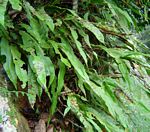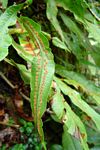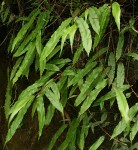Oleandra distenta
Selected images: Click on each image to see a larger version and details of the record View all images (16)
Detailed records: Display species records QDS maps by: Google Maps Point records by Google Maps
Species details: Click on each item to see an explanation of that item (Note: opens a new window)
| Synonyms: |
Aspidium articulatum (Juss. ex Poir.) Willd. Oleandra africana Bonap. Oleandra articulata 'Cav.' var. welwitschii Bak. Oleandra densifrons Kunze Oleandra distenta Kunze var. hirsuta Tardieu Oleandra distenta Kunze var. villosa Tardieu Oleandra distenta Kunze var. welwitschii (Baker) Kornas Oleandra welwitschii (Baker) Pic.Serm. |
| Common names: | |
| Frequency: | |
| Status: | Native |
| Description: |
Rhizome long creeping, up to 4 mm in diameter, scandent, branched; rhizome scales appressed, shiny, lanceolate, up to 7 mm long, with a dark brown central stripe and paler ciliate margins. Roots thin, wiry, singly below each old frond. Fronds widely spaced on rhizome or on short side branches, erect to arching, deciduous, simple. Stipe articulated near the base, up to 6 cm long, covered with scattered scales similar to, but smaller than those on the rhizome. Lamina 14-33 × 1.5-6.5 cm, glabrous on both surfaces, thinly membranous (dry) to thinly coriaceous, linear lanceolate in outline, base wedge-shaped, apex abruptly ending in a tip, margin subentire, wavy; midrib prominent below; veins obvious, simple, sometimes forked near the costa, finely parallel. Sori circular, up to 2.5 mm in diameter, in a irregular line on either side of the midrib, situated within the inner half of the lamina; indusium round to kidney-shaped, small, hairless, dark brown, entire. |
| Type location: |
|
| Notes: | Can be separated from other ferns by the rampant rhizome with long filiform roots, the articulated stipe, the sori that are placed in 2 irregular rows on either side of the midrib and the round to kidney shaped indusium. |
| Derivation of specific name: | distenta: extended, stretched out; possibly referring to the widely spaced fronds on the widely creeping rhizome. |
| Habitat: | In high rainfall areas on boulders in riverine or montane forest, sometimes scrambling in trees in evergreen forest, or as a lithophyte on rock faces on mountain peaks. |
| Altitude range: (metres) | 860 - 1850 m |
| Worldwide distribution: | Widespread in tropical and southern Africa. |
| FZ divisions: | N,C,E |
| Growth form(s): | Epiphyte, lithophyte. |
| Endemic status: | |
| Red data list status: | |
| Insects associated with this species: | |
| Spot characters: | Display spot characters for this species |
| Images last updated: | Saturday 18 August 2012 |
| Literature: |
Burrows, J.E. (1990). Southern African Ferns and Fern Allies. Frandsen, Sandton. Pages 208 - 209. (Includes a picture). Burrows, J.E. & Burrows, S.M. (1993). An annotated check-list of the pteridophytes of Malawi Kirkia 14(1) Page 91. Burrows, J.E. & Willis, C.K. (eds) (2005). Plants of the Nyika Plateau Southern African Botanical Diversity Network Report No. 31 SABONET, Pretoria Page 36. as Oleandra distenta distenta (Includes a picture). Chapano, C. & Mamuto, M. (2003). Plants of the Chimanimani District National Herbarium and Botanic Garden, Zimbabwe Page 41. Crouch, N.R., Klopper, R.R., Burrows, J.E. & Burrows, S.M. (2011). Ferns of Southern Africa, A comprehensive guide Struik Nature Pages 528 - 529. (Includes a picture). Da Silva, M.C., Izidine, S. & Amude, A.B. (2004). A preliminary checklist of the vascular plants of Mozambique. Southern African Botanical Diversity Network Report No. 30 Sabonet, Pretoria Page 16. Dowsett-Lemaire, F. (1989). The flora and phytogeography of the evergreen forests of Malawi. I: Afromontane and mid-altitude forests; Bull. Jard. Bot. Nat. Belg. 59(1/2) Page 26. Fischer E. & Lobin W. (2024). Checklist of Lycopodiopsida (clubmosses and quillworts) and Polypodiopsida (ferns) of Rwanda. Willdenowia 53(3) Page 163. Fischer, E. & Killmann, D. (2008). Illustrated Field guide to the Plants of Nyungwe National Park Rwanda. University of Koblenz-Landau. Page 94. (Includes a picture). Jacobsen, W.B.G. (1983). The Ferns and Fern Allies of Southern Africa. Butterworths, Durban and Pretoria. Pages 326 - 327. (Includes a picture). Kornas, J. (1979). Distribution and ecology of the Pteridophytes in Zambia Polska Akademia Nauk Wydzial II Nauk Biologicznych Pages 112 - 113. Mapaura, A. & Timberlake, J. (eds) (2004). A checklist of Zimbabwean vascular plants Southern African Botanical Diversity Network Report No. 33 Sabonet, Pretoria and Harare Page 8. Ntore, S. & al. (2024). Checklist of the vascular plants of Burundi Page 33. Roux, J.P. (2001). Conspectus of Southern African Pteridophyta. Southern African Botanical Diversity Network Report 13 Page 142. (Includes a picture). Roux, J.P. (2009). Synopsis of the Lycopodiophyta and Pteridophyta of Africa, Madagascar and neighbouring islands Page 149. Schelpe, E.A.C.L.E. (1970). Pteridophyta Flora Zambesiaca Pages 165 - 166. (Includes a picture). Wursten, B., Timberlake, J. & Darbyshire, I. (2017). The Chimanimani Mountains: an updated checklist. Kirkia 19(1) Page 79. |
Other sources of information about Oleandra distenta:
Our websites:
Flora of Burundi: Oleandra distentaFlora of the DRC: Oleandra distenta
Flora of Malawi: Oleandra distenta
Flora of Mozambique: Oleandra distenta
Flora of Rwanda: Oleandra distenta
Flora of Zambia: Oleandra distenta
External websites:
African Plants: A Photo Guide (Senckenberg): Oleandra distentaAfrican Plant Database: Oleandra distenta
BHL (Biodiversity Heritage Library): Oleandra distenta
EOL (Encyclopedia of Life): Oleandra distenta
GBIF (Global Biodiversity Information Facility): Oleandra distenta
Google: Web - Images - Scholar
iNaturalist: Oleandra distenta
IPNI (International Plant Names Index): Oleandra distenta
JSTOR Plant Science: Oleandra distenta
Mansfeld World Database of Agricultural and Horticultural Crops: Oleandra distenta
Plants of the World Online: Oleandra distenta
Tropicos: Oleandra distenta
Wikipedia: Oleandra distenta


